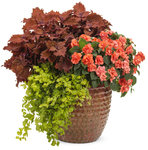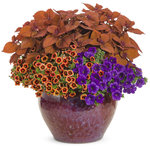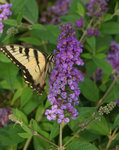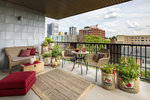All Articles
Orange may not be the most popular color for gardeners, but don’t hold that against it.
Knowing a bit about color theory can help you design color combinations that really stand out. One color scheme is called a color triad. This way of combining colors uses an equilateral triangle that is put in the middle of a color wheel. Choose the color that each tip of the triangle touches and you’ll have a color triad. In this case we used a very simple, 6-color color wheel, which yields one color triad composed of orange, violet and green.
I wish I could claim this idea as my own, but it is one I learned of a few years ago when I visited the University of Tennessee Gardens in Knoxville. They had several different gardens that would surely appeal to children, including a garden gnome village and a hobbit house to explore. However, the garden that caught my eye was the Plant Zoo. The plant zoo was planted with varieties whose names referenced animals of all kinds. Sometimes the names were specific plant names, like Tiger Lily, but others were common names like Lambs Ear. The tags in the garden used outlines of the animal in the plant name. I love the concept and I think this would be easy enough to pull off in your home garden with your kids or grandkids helping. Such an easy way to get a child interested in a garden! The plant tags the University had, might not be easily replicated. However, if you want to ID your plants, I think clip art, Sharpies, river rocks, and mod podge would allow the kids to make rock markers for your zoo garden in no time!
Studies show spending time in gardens and green spaces or directly nurturing plants, is healthy for us. In fact, hospitals often use surrounding gardens and plants in therapeutic programs. This realization also leads to another great reality; we need to plant, protect and conserve our plants and green spaces.
Summerific® Hibiscus are showstoppers in the landscape, especially when they are in bloom, but every headliner needs backup singers. Here are 10 plants that make great companions for these robust perennials.
Have you seen the dinner plate-sized Hibiscus blooming around town this summer? They are easier to grow than you might think, even if you live someplace with very cold winters. Here are five helpful tips for growing your own glorious Summerific® Hibiscus.
You could harvest your next meal from your expansive vegetable garden, but what if you’re someone who gardens solely on a balcony or don’t have room for a dedicated veggie patch? Good news! You can grow plenty of herbs, small fruits and vegetables in containers, and you might find a few edible flowers growing in your landscape, too. Here are five tips to get you started.
Here at Proven Winners, we love vigorous plants - they so often go hand-in-hand with great garden performance. And great garden performance is our number one criteria when we select plants to add to our program, however, huge plants are not the answer in all situations. Sometimes a petite plant is exactly what you need! Here are eleven varieties that pack a wallop in a small package and deliver nonstop color all summer long.
It can be challenging to continuously come up with new ideas for plant lists. Many of our lists are all about solving a potential question. Things like: What are some great blue plants? What plants do pollinators love? What annuals are perfect for the middle of the border? We’ve made dozens of plant lists available to gardeners over the years. Sometimes we take a break from solving garden questions and create a list just for fun – and this is one of those times! These plants aren’t edible. You can’t use them in cocktails. They don’t necessarily have anything in common other than they are named after cocktails or ingredients in cocktails. Naming is hard. Is it possible some of these names were created while drinking cocktails? Hmmm, maybe we should leave that a mystery…
I love plants and adore the flowers that fill my garden with color, fragrance, and beauty. But my garden would be only half a garden without the birds, hummingbirds, bees and butterflies that fill the space with graceful movement, birdsong, and the low rumbling buzz of bumblebees. These 10 red or nearly red flowers are sure to be a hit with hummingbirds. Add enough of these plants to your garden and you’ll never have to fill a hummingbird feeder again!












